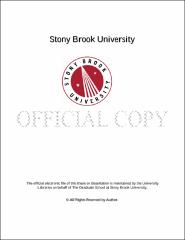| dc.identifier.uri | http://hdl.handle.net/11401/76998 | |
| dc.description.sponsorship | This work is sponsored by the Stony Brook University Graduate School in compliance with the requirements for completion of degree. | en_US |
| dc.format | Monograph | |
| dc.format.medium | Electronic Resource | en_US |
| dc.language.iso | en_US | |
| dc.publisher | The Graduate School, Stony Brook University: Stony Brook, NY. | |
| dc.type | Dissertation | |
| dcterms.abstract | Red Blood Cell (RBC) aggregation is an important hemorheological phenomenon especially in microcirculation. In healthy individuals, RBCs are known to aggregate and gravitate toward the faster flow in the center of vessels to increase their throughput for more efficient oxygen delivery. Their aggregation is known to occur during a variety of environmental, pathological, and physiological conditions and is reversible when aggregates are subject to the relatively high shear forces in the circulation. The likelihood that aggregates will monodisperse in flow is dependent on the conditions during which they form. In situations where such aggregates are not sheared to monodispersion their presence can impact the perfusion of microvascular networks. More specifically, aggregates subject to the low shear rates in the zone of stasis near regions of thermal burn injury are capable of occluding vessels in the microcirculation and inhibiting the delivery of oxygen and nutrients to tissue downstream. The basic mechanism leading to erythrocyte aggregation at the onset of thermal injury is unknown. This dissertation investigates parameters involved in erythrocyte aggregation, methods of measuring and testing erythrocyte aggregation, and incorporates modeling based on first principles ultimately to propose a mechanism of this phenomenon. | |
| dcterms.available | 2017-09-20T16:51:37Z | |
| dcterms.contributor | Yin, Wei | en_US |
| dcterms.contributor | Frame, Mary D. | en_US |
| dcterms.contributor | Rubenstein, David | en_US |
| dcterms.contributor | Pittman, Roland. | en_US |
| dcterms.creator | Seidner, Harrison Steven | |
| dcterms.dateAccepted | 2017-09-20T16:51:37Z | |
| dcterms.dateSubmitted | 2017-09-20T16:51:37Z | |
| dcterms.description | Department of Biomedical Engineering. | en_US |
| dcterms.extent | 190 pg. | en_US |
| dcterms.format | Monograph | |
| dcterms.format | Application/PDF | en_US |
| dcterms.identifier | http://hdl.handle.net/11401/76998 | |
| dcterms.issued | 2016-12-01 | |
| dcterms.language | en_US | |
| dcterms.provenance | Made available in DSpace on 2017-09-20T16:51:37Z (GMT). No. of bitstreams: 1
Seidner_grad.sunysb_0771E_12770.pdf: 10126500 bytes, checksum: b1d8c67e712609c35135e8b1b4483bdb (MD5)
Previous issue date: 1 | en |
| dcterms.publisher | The Graduate School, Stony Brook University: Stony Brook, NY. | |
| dcterms.subject | Biomedical engineering | |
| dcterms.subject | Aggregation, Erythrocyte, Microcirculation, Microfluidics, nanobubble, oxygen | |
| dcterms.title | Erythrocyte Aggregation due to Surface Nanobubble Interactions During the Onset of Thermal Burn Injury | |
| dcterms.type | Dissertation | |

